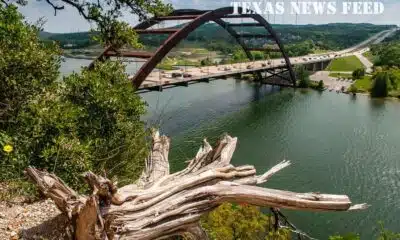News from the South - North Carolina News Feed
When will railroad tracks get repaired here? Why so many water alerts? What type of clay is causing the turbidity problem? Could the city directly pipe the clear streams nearby? • Asheville Watchdog
Today’s round of questions, my smart-aleck replies and the real answers:
Question: Will Norfolk & Southern repair their tracks? It’s such a sleepy industry, they may not be able to get a return on the investment. Rails to trails?
My answer: When it comes to repairs, I feel like Norfolk Southern is saying more, “I think I can, I think I can,” rather than, “Yeah, these tracks are toast. Time for rails to trails.”
Real answer: Norfolk Southern owns a lot of our tracks around here. Company spokesperson Heather L. Garcia provided the company’s update on Helene recovery.
“The short version is our track in and out of Asheville is expected to be out for at least another three months,” Garcia said.
The track is still used quite a bit, although Norfolk Southern does consider it “secondary” track, not part of its mainline operations.
“Essentially, that means most of the traffic on that track is local (as opposed to through traffic), serving customers that are shipping goods out or bringing products in,” Garcia said. “Coal, forest and consumer categories make up more than half of the traffic in that area normally.”
In that update, Norfolk Southern said all of its “core routes were open within 72 hours of the hurricane making landfall.” The railroad has 19,500 miles of track in 22 states, mostly in the East.

“Norfolk Southern’s Engineering team cleared over 15,000 trees, repaired multiple washouts and over 50 damaged slide fences, deployed 400-plus generators, and safely operated in more than 1,000 locations without commercial power,” the update stated.
The update notes that the Asheville region was hard hit.
“In the hardest hit areas, along Norfolk Southern’s AS Line, which runs from Salisbury, N.C to Morristown, Tenn., crossing the Eastern Continental Divide through the Blue Ridge Mountains and Asheville, N.C., initial damage assessments discovered 21,500 feet of track washed out, more than 50,000 feet of track damaged by scour, over 15,000 feet of fill failures and slides, and multiple bridges damaged,” Norfolk Southern stated. “Engineering teams reopened the AS Line between Salisbury, N.C. and Old Fort, N.C., as well as between Newport, Tennessee and Morristown, Tennessee, Oct. 9, working, in some cases, without access to public roadways.”
Because of the remoteness and mountain topography, along with storm flooding, “Norfolk Southern teams have had difficulty assessing damage along portions of the line around Asheville and over Black Mountain, where much track has been completely destroyed,” the company stated.

“Initial projections estimate Norfolk Southern’s line between Asheville and Newport will reopen by late January 2025,” the update continued. “Evaluations of the track between Asheville and Old Fort are ongoing.”
Blue Ridge Southern Railway, under its parent company, Watco, also operates tracks in our area, running from East Flat Rock up to Asheville, and then west to Dillsboro. The “WAMX” locomotives you often see around here, which stand for Webb Asset Management, are part of the Blue Ridge Southern Railroad.
The Blue Ridge Southern line consists of 87.83 miles of track, according to Watco spokesperson Tracie VanBecelaere.
“The Blue Ridge Southern Railroad is working to restore the line to resume service to our customers,” VanBecelaere said via email. “We do not have an exact timeline right now on when work will be completed, but hopefully in a similar timeframe as Norfolk Southern.”
As far as any potential transitioning of tracks to pedestrian/cycling trails, that’s not happening.
“There is no discussion of trail projects resulting from the storm,” VanBecelaere said.

Question: I appreciate the city being responsive during this crisis, but do they really need to send out so many alerts about the water? It’s starting to drive me crazy.
My answer: Alert! Alert! Alert! An Alert answer is coming. Hey, I just wanted to warn you.
Real answer: Asheville City Manager Debra Campbell broached this subject at the Oct. 21 daily Helene briefing. In short, the city must issue these notices.
“We’ve heard a lot, and a lot of it were mostly complaints that there’s been some frustration with the daily AVL alert messages going out to Asheville water customers as we continue to bring the entire water system back online,” Campbell said. “These daily boil water notices are required by the Environmental Protection Agency.”
“As long as we are under a boil water notice, we appreciate your understanding of the necessity of these critical messages,” Campbell continued. “These alerts are sent in both English and Spanish to ensure we reach as many members of our community as possible.”
Asheville has restored water to nearly all its customers, but the water is not filtered, and it’s heavily chlorinated and can have a light brown appearance. This stems from stubborn suspended clay particles remaining in the city’s main drinking water source, North Fork Reservoir in Black Mountain.

Question: (Note: Two readers asked about the turbidity issue at North Fork Reservoir. I’m summarizing their questions here). One guy said he filtered the city water through three towels, and it still came through with a brownish color, and yet there seemed to be no residue left behind on the towels. This indicated to him that the particles in question are incredibly fine. Along those lines, another guy, with experience in pottery, asked if the type of clay in the reservoir might be something called “terra sigillata.” Apparently, this is a fine clay used to create a smooth, lustrous coating on ceramic pieces, according to Google. His point is that it is a very, very fine clay and stays in suspension for a long time. He wanted more specifics on the suspended clay the city is dealing with, other than just generic clay. Also, he asked if the curtains to be installed are effective on very fine clay particles. And, how small a particle can they filter?
My answer: I’ve yet to hear the city’s water spokesperson, Clay Chandler, acknowledge the awkwardness of being named “Clay” these days, but I suspect that’s coming. I also suspect he’s already had some people blame him personally for muddying the waters.
Real answer: Chandler said the particles in North Fork that are causing the murkiness, technically called turbidity, are “very fine clay particles and generally require a coagulant to remove.

“A towel is porous, with those pores being large enough that they would most likely be unable to trap or contain those particular particles,” Chandler said via email. “Our personnel have not identified the specific clay particle, and use that term generically to describe many variations.”
They clearly have looked at this clay up close and personal, though.
“We do know that these particles are small, flat, plate-like structures, with a negative charge, and they act as opposing magnets, which keeps them suspended in the reservoir,” Chandler said.
Regarding the turbidity curtains, which the city is installing this week, they “are impervious in areas, but are mostly intended to create a stilling zone to allow flocculation and mass building, which we hope will help these particles sink,” Chandler said.
Flocculation is a fancy way to describe a process that causes small particles in a liquid to clump together into larger clusters called flocs. Hey, that’s what Google AI tells me.
Floc away, Asheville!

Question: As the feeder streams to North Fork have cleared, has the city explored the possibility, maybe in conjunction with the Corps of Engineers, of directly piping the stream water into the treatment facility, essentially bypassing the lake? Is this possible? Too complex?
My answer: At this point, I think the city has explored every possible solution to restoring potable water to its citizens, including buying gigantic tanks of hydrogen and oxygen and leaving them in a room overnight, hoping some magic occurs.
Real answer: This would probably be too complicated to seriously consider.
“Lot of problems to solve,” Chandler said. “None of those feeder streams are very deep, so you’d run into the capacity issue there, too. Also, they’re all in the middle of thick forest, and getting what would likely require a few miles of connected pipe laid and stabilized would take a significant amount of time.”
Also, the terrain provides no good place to set up dozens of pumps and other equipment that would be required to make this work.
Asheville Watchdog is a nonprofit news team producing stories that matter to Asheville and Buncombe County. Got a question? Send it to John Boyle at jboyle@avlwatchdog.org or 828-337-0941. His Answer Man columns appear each Tuesday and Friday. The Watchdog’s reporting is made possible by donations from the community. To show your support for this vital public service go to avlwatchdog.org/support-our-publication/.
Related
The post When will railroad tracks get repaired here? Why so many water alerts? What type of clay is causing the turbidity problem? Could the city directly pipe the clear streams nearby? • Asheville Watchdog appeared first on avlwatchdog.org
News from the South - North Carolina News Feed
White House officials hold prayer vigil for Charlie Kirk
SUMMARY: Republican lawmakers, conservative leaders, and Trump administration officials held a prayer vigil and memorial at the Kennedy Center honoring slain activist Charlie Kirk, founder of Turning Point USA. Kirk was killed in Utah, where memorials continue at Utah Valley University and Turning Point USA’s headquarters. Police say 22-year-old Tyler Robinson turned himself in but has not confessed or cooperated. Robinson’s roommate, his boyfriend who is transitioning, is cooperating with authorities. Investigators are examining messages Robinson allegedly sent on Discord joking about the shooting. Robinson faces charges including aggravated murder, obstruction of justice, and felony firearm discharge.
White House officials and Republican lawmakers gathered at the Kennedy Center at 6 p.m. to hold a prayer vigil in remembrance of conservative activist Charlie Kirk.
https://abc11.com/us-world/
Download: https://abc11.com/apps/
Like us on Facebook: https://www.facebook.com/ABC11/
Instagram: https://www.instagram.com/abc11_wtvd/
Threads: https://www.threads.net/@abc11_wtvd
TIKTOK: https://www.tiktok.com/@abc11_eyewitnessnews
News from the South - North Carolina News Feed
Family, friends hold candlelight vigil in honor of Giovanni Pelletier
SUMMARY: Family and friends held a candlelight vigil in Apex to honor Giovanni Pelletier, a Fuquay Varina High School graduate whose body was found last month in a Florida retention pond. Giovanni went missing while visiting family, after reportedly acting erratically and leaving his cousins’ car. Loved ones remembered his infectious smile, laughter, and loyal friendship, expressing how deeply he impacted their lives. His mother shared the family’s ongoing grief and search for answers as authorities continue investigating his death. Despite the sadness, the community’s support has provided comfort. A celebration of life mass is planned in Apex to further commemorate Giovanni’s memory.
“It’s good to know how loved someone is in their community.”
More: https://abc11.com/post/giovanni-pelletier-family-friends-hold-candlelight-vigil-honor-wake-teen-found-dead-florida/17811995/
Download: https://abc11.com/apps/
Like us on Facebook: https://www.facebook.com/ABC11/
Instagram: https://www.instagram.com/abc11_wtvd/
Threads: https://www.threads.net/@abc11_wtvd
TIKTOK: https://www.tiktok.com/@abc11_eyewitnessnews
News from the South - North Carolina News Feed
NC Courage wins 2-1 against Angel City FC
SUMMARY: The North Carolina Courage defeated Angel City FC 2-1 in Cary, ending their unbeaten streak. Monaca scored early at the 6th minute, followed by Bull City native Brianna Pinto’s goal at the 18th minute, securing a 2-0 halftime lead. Angel City intensified in the second half, scoring in the 88th minute, but the Courage held firm defensively to claim victory. Pinto expressed pride in the win, emphasizing the team’s unity and playoff ambitions. Nearly 8,000 fans attended. Coverage continues tonight at 11, alongside college football updates, including the Tar Heels vs. Richmond game live from Chapel Hill.
Saturday’s win was crucial for the Courage as the regular season starts to wind down.
https://abc11.com/post/north-carolina-courage-wins-2-1-angel-city-fc/17810234/
Download: https://abc11.com/apps/
Like us on Facebook: https://www.facebook.com/ABC11/
Instagram: https://www.instagram.com/abc11_wtvd/
Threads: https://www.threads.net/@abc11_wtvd
TIKTOK: https://www.tiktok.com/@abc11_eyewitnessnews
-
News from the South - Kentucky News Feed7 days ago
Lexington man accused of carjacking, firing gun during police chase faces federal firearm charge
-
News from the South - Alabama News Feed7 days ago
Zaxby's Player of the Week: Dylan Jackson, Vigor WR
-
News from the South - Arkansas News Feed7 days ago
Arkansas medical marijuana sales on pace for record year
-
News from the South - North Carolina News Feed5 days ago
What we know about Charlie Kirk shooting suspect, how he was caught
-
Local News7 days ago
US stocks inch to more records as inflation slows and Oracle soars
-
Local News6 days ago
Russian drone incursion in Poland prompts NATO leaders to take stock of bigger threats
-
Local News Video6 days ago
Introducing our WXXV Student Athlete of the Week, St. Patrick’s Parker Talley!
-
News from the South - North Carolina News Feed5 days ago
Federal hate crime charge sought in Charlotte stabbing | North Carolina















































